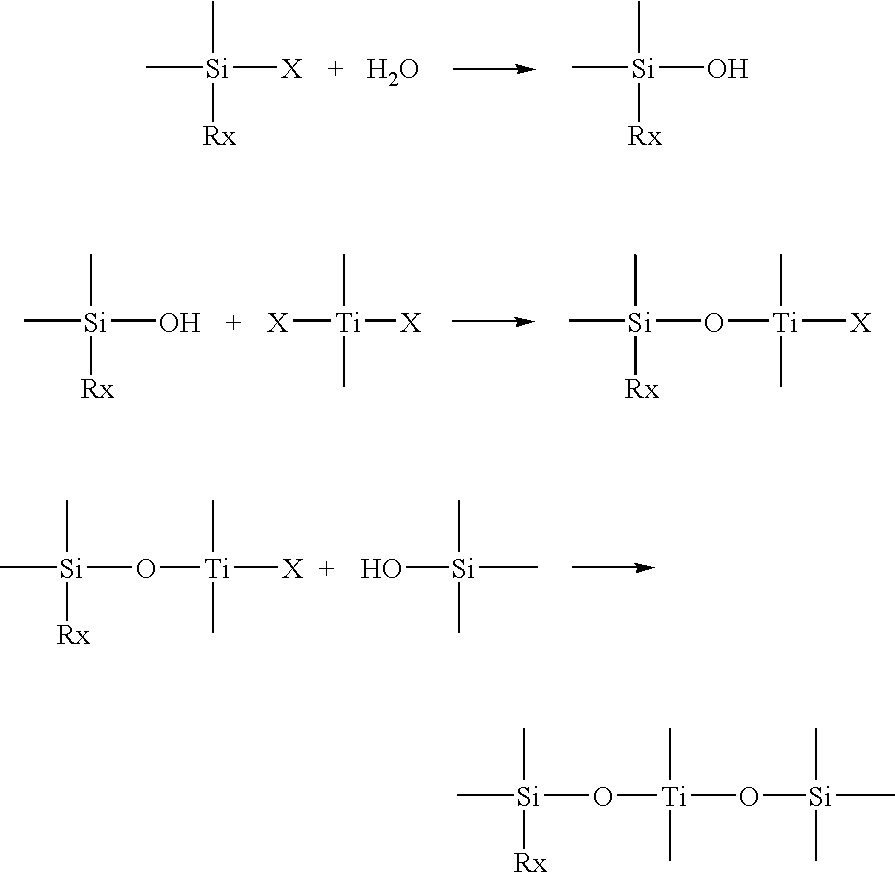Oil-, hot water-and heat-resistant binders, process for preparing them and their use
- Summary
- Abstract
- Description
- Claims
- Application Information
AI Technical Summary
Benefits of technology
Problems solved by technology
Method used
Image
Examples
example 2
[0127]11.85 g of MTEOS (6.65 mmol), 5.22 g of MPTS (21.02 mmol), 0.445 g of VTES (0.23 mmol), 5.72 g of TEOS (27.47 mmol) and 8.4 g of poly(diethoxysilane) (20.5-21.5% of Si) are mixed, and a mixture of 0.38 g of 37% HCl and 2.91 g of water (0.162 mol) is added with stirring. As soon as the transition point of the sol is reached within 1-2 minutes, 10.04 g of TPT (35.3 mmol) are added to the sol in one shot. After stirring overnight, 3.2 g of water (0.178 mol) are added dropwise to the sol and stirring is continued for 30 min. Thereafter, an acrylate mixture comprising 8.26 g of diurethane dimethacrylate, 2.3 g of diethylene glycol dimethacrylate and 10.48 g of bisphenol A diacrylate is added. 0.32 g of Trigonox® 121 is then added as a thermal initiator. A molding is produced as in Example 1.
[0128]The compressive strength of the molding produced was 4.3 MPa.
example 3
[0129]11.85 g of MTEOS (6.65 mmol), 5.22 g of MPTS (21.02 mmol), 0.445 g of VTES (0.23 mmol), 5.72 g of TEOS (27.47 mmol) and 3.77 g of polydimethylsiloxane having terminal hydroxyl groups (molecular weight of 400-700 g / mol) are mixed, and a mixture of 0.38 g of 37% HCl and 2.34 g of water (0.13 mol) is added with stirring. As soon as the transition point of the sol is reached within 1-2 minutes, 10.04 g of TPT (35.3 mmol) are added to the sol in one shot. After stirring overnight, 2.54 g of water (0.141 mol) are added dropwise to the sol and stirring is continued for 30 min. Thereafter, an acrylate mixture comprising 8.26 g of diurethane dimethacrylate, 2.3 g of diethylene glycol dimethacrylate and 10.48 g of bisphenol A diacrylate was added. 0.32 g of Trigonox® 121 was then added as a thermal initiator. The molding was produced as in Example 1.
[0130]The compressive strength of the molding produced was 4.8 MPa.
example 4
[0131]11.85 g of MTEOS (6.65 mmol), 5.22 g of MPTS (21.02 mmol), 0.445 g of VTES (0.23 mmol), 5.72 g of TEOS (27.47 mmol) and 3.77 g of polydimethylsiloxane having terminal hydroxyl groups (molecular weight of 1500-2000 g / mol) were mixed and a mixture of 0.38 g of 37% HCl and 2.34 g of water (0.13 mol) was added with stirring. 10.04 g of TPT (35.3 mmol) were added to the sol in one shot 1-2 minutes after the addition of HCl and water. After stirring overnight, 2.54 g of water (0.141 mol) were added dropwise to the sol and stirring was continued for 30 minutes. Thereafter, an acrylate mixture comprising 8.26 g of diurethane dimethacrylate, 2.3 g of diethylene glycol dimethacrylate and 10.48 g of bisphenol A diacrylate was added. 0.32 g of Trigonox® 121 was then added as a thermal initiator. The molding was produced as in Example 1.
[0132]The compressive strength of the molding produced was 5.9 MPa.
PUM
| Property | Measurement | Unit |
|---|---|---|
| Time | aaaaa | aaaaa |
| Time | aaaaa | aaaaa |
| Time | aaaaa | aaaaa |
Abstract
Description
Claims
Application Information
 Login to View More
Login to View More - R&D
- Intellectual Property
- Life Sciences
- Materials
- Tech Scout
- Unparalleled Data Quality
- Higher Quality Content
- 60% Fewer Hallucinations
Browse by: Latest US Patents, China's latest patents, Technical Efficacy Thesaurus, Application Domain, Technology Topic, Popular Technical Reports.
© 2025 PatSnap. All rights reserved.Legal|Privacy policy|Modern Slavery Act Transparency Statement|Sitemap|About US| Contact US: help@patsnap.com


